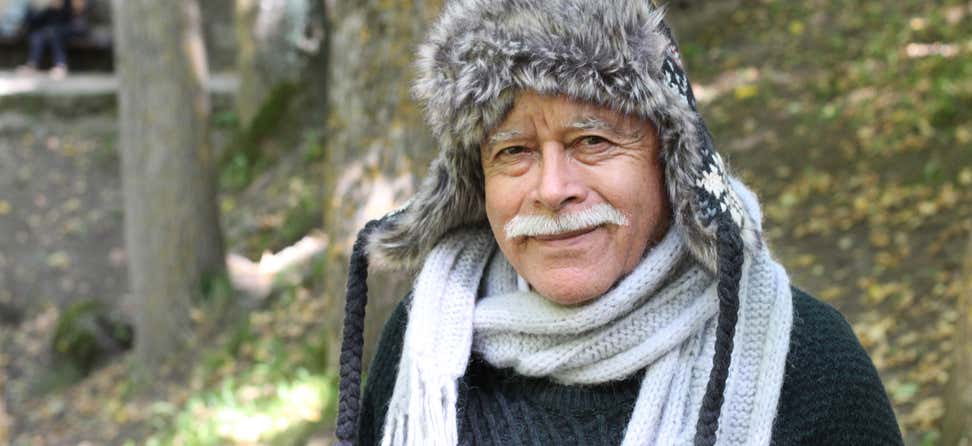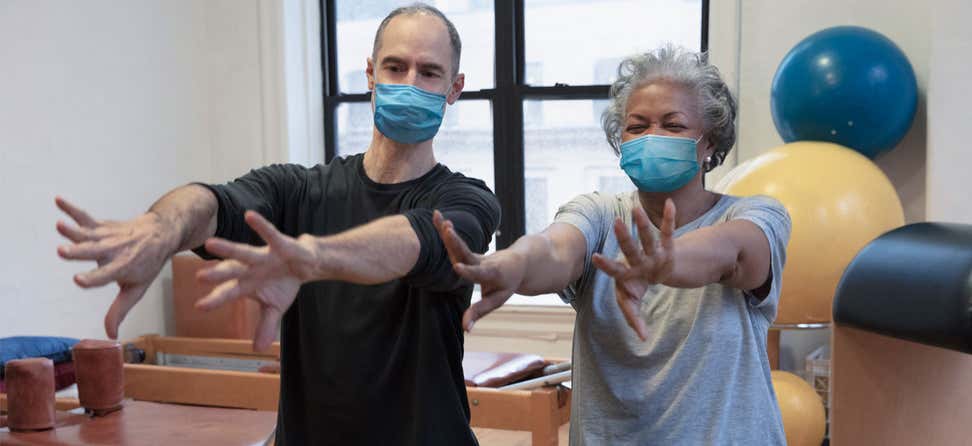Key Takeaways
Find an overview of health disparities in chronic diseases among American Indian/Alaska Native/Native Hawaiian (AI/AN/NH) communities.
Learn more about strategies for increasing access to chronic disease self-management education (CDSME) programs.
Get information about the Wisdom Warriors Program, along with activities of current and former grantees funded by the Administration for Community Living (ACL).
Health Disparities
The AI/AN/NH population experiences significant health disparities as compared to the general United States populationi and a heavier burden of chronic illness. One in five of 5.4 million AI/AN/NHs have two or more chronic conditions, with heart disease and cancer as the leading causes of death. Other chronic conditions, such as obesity and diabetes are also prevalent among AI/AN/NHs.
- Forty percent of AI/AN/NH adults are classified as obese, compared to 28% of nonHispanic Whites.2
- Over 30% of AI/AN/NH adults reported at least one form of heart disease in 2012, compared with 11% of non-Hispanic Whites.3
- Twenty percent of AI/AN/NHs have been diagnosed with diabetes, compared to 12% of non-Hispanic Whites.4
A combination of complex factors contributes to health disparities among AI/AN/NHs, including the lack of or discrimination in the delivery of education and health care services, disproportionate rates of poverty, and high numbers of uninsured individuals. Environmental factors and cultural traditions and beliefs may also play a role.7
Benefits of CDSME Interventions
Evidence-based CDSME interventions, such as the Chronic Disease Self-Management Program (CDSMP),8 have been proven to help people with chronic conditions manage their health and improve their quality of life.9 Research has shown that CDSMP significantly improves self-reported health, communication with doctors, and appropriate medication use, while lowering health care costs.10 When provided in a culturally competent manner, with respect for the traditions, beliefs, practices, and needs of AI/AN/NHs, CDSME programs can be an effective intervention. Many ACL grantees across the country have successfully offered CDSME programs in partnership with tribes to help AI/AN/NHs learn how to manage their chronic conditions and improve their health status.
Strategies for Collaborating with Tribal Communities
As you work to grow and sustain your CDSME programs, the strategies outlined below can help you develop relationships with tribal representatives and increase the likelihood that your outreach and CDSME program implementation efforts will be successful.
Plan for Success
Consistent with CDSME programs’ focus on setting achievable, short-term goals, it is important to start out small with specific, attainable goals and a realistic timeline. For example, consider the number of tribal members that will enroll in the program over the next six months or the number of tribal members that will be trained to lead workshops over the next year. Participation may be smaller than you would expect. In getting started, it will be helpful to develop a written program implementation plan, which includes quality assurance activities, the necessary partnerships, and potential funding streams to sustain your program.
In order to include cultural competency in your program, tribal members should provide input into the planning process, as well as help solve challenges that may be faced during implementation of the program. Involving tribal representatives and other key partners and stakeholders in the planning, implementation, and evaluation phases of your program will help assure its success.
Assess Your Organizational Readiness to Serve Tribal Communities
A great deal of time and effort will be required to build trust and establish a culturally relevant, sustainable program infrastructure. It is important to carefully assess to what extent your organization has sufficient overall resources for a long-term commitment before you initiate the relationship. As part of this process, ensure that you have an understanding of the population and their specific preferences and needs. Additionally, you should work with tribal members to identify champions within the tribe(s) and partners who can help you get started and build capacity for your program. Below are some questions to consider as you determine your readiness:
- Are your senior management, staff, and volunteer leadership committed to this effort for the long term?
- Is the commitment backed up by the allocation of adequate resources?
- What formal mechanisms are in place within your organization to ensure that the work with tribes is embedded in your organization and not dependent on one person?
- Are any of your organization’s staff, board of directors, or volunteers tribal members? If so, these individuals may become your champions.
- Has your organization involved community leaders from tribes in planning? If not, what steps can you take to involve tribal representatives?
- How will you assure that your organization’s staff and volunteers are culturally competent?
- What partners can you engage to help with your outreach efforts?
- Has your organization already provided services to any tribal communities? What feedback did you receive that could be applied to this effort, with the understanding that every tribe is autonomous; each with its own unique government, culture, and beliefs.
Ask the Tribe About Their Needs
Conduct background research, and be eager to learn from the tribe itself. Below are tips to help you in learning about the tribe.
- Understand how to pronounce tribal names and places.
- What public data is available about the prevalence of chronic diseases within the tribe (e.g., Indian Health Service, state public health department or state unit on aging reports, Centers for Disease Control and Prevention data, etc.)?
- What tribal needs assessments are already available that could help determine if CDSME programs are a good fit? The National Resource Center for Native American Aging supports tribes in completing community needs assessments. These reports are available only if the tribe is willing to share them. Needs assessments can help identify issues such as high prevalence of chronic illnesses, frequency of falls, etc.
- What are the tribe’s goals related to chronic disease? What specific goals doesyour tribal partner have (e.g., reducing complications from diabetes among their members, improving overall community health, or developing champions for CDSMP within the tribe)?
Learn More About the Tribe’s gGovernmental and Social Structure
Understand how the tribe is structured so that you can appropriately target your outreach efforts. Below are some key considerations.
- What is the tribal government/council structure and membership and who are the leaders and respected decision makers within the tribe?
- Does the tribe have departments or other entities that could assist with CDSME efforts (e.g., a tribal aging unit, health clinic, elderly or health advisory board, nutrition and/or health education department, tribal outreach department, etc.)?
- Where does the tribal population live and what is the geographic reach of the tribe? Where would they like to focus outreach efforts?
- What is the preferred language in the tribe?
Leverage Existing Resources
Consider how you can leverage existing resources to help with your efforts to engage the tribe in offering CDSME programs.
- What health professionals, medical centers, health departments, area agencies on aging, technical assistance centers, or other agencies are already serving the community?
- What types of chronic disease prevention and health promotion programs are already being offered to the community?
- What other grants has the tribe received that support chronic disease prevention or treatment? For example, the Indian Health Service Division of Diabetes Treatment and Prevention provides Special Diabetes Program for Indians (SDPI) grants. This funding provides support for evidence-based interventions in over 300 AI/AN/NH communities in 35 states to treat and prevent diabetes.
Ensure a Culturally Competent Workforce
Develop sound policies and practices within your organization to assure that staff and volunteers understand tribal culture, and are attentive to their needs.
An important part of cultural sensitivity is understanding the tribe’s beliefs about chronic illnesses and self-care practices.
Further, learning about the role of clinics, health centers, or other medical services, as well as traditional healers, will help with your efforts to engage the tribe. Below are some key points to keep in mind as you work toward building a relationship.
- Recognize that what has worked with one tribe will not necessarily work with another. All tribes are different.
- Approach the community with an open mind and an interest in and respect for the tribe’s culture.
- Honor the tribe’s self-determination and respect their sovereignty.
- Acknowledge that your organization doesn’t have all the answers. Be prepared to ask: “What next steps would be the most helpful to you?”
- Recognize that elders are not only “participants” but also important and well-respected parents, grandparents, healers, and leaders in their communities.
- Understand that tribal members may not have had positive interactions in the past with outside people or organizations that provided shortterm, “flash in the pan” health promotion offerings.
- Expect that building relationships will take time. Be patient and understand that this needs to be an ongoing process, not just a onetime effort. If possible, identify a problem with a quick solution and solve it. This will begin a foundation of credibility and a real interest in action.
Establish Champions and Strong Tribal Community Infrastructure
As you develop your plan, identify key individuals who are known, respected, and influential within the community.
- Who are the respected elders or other community leaders that you can engage as program champions?
- Which health professionals, allied health professionals, community health workers, and others already working with the tribe can help with your efforts?
- Are tribal members who offer other health promotion programs available to assist you?
The CDSME program delivery infrastructure needs to be integrated within the tribal community in order to be effective and sustainable. To establish a strong infrastructure, involve tribal members in planning and scheduling the workshops. Holding the workshops at times and locations that are convenient to potential participants will increase the success of the program. Places where tribal members typically congregate with accessible transportation are ideal. Considerations should be made for tribal holidays and other cultural events. Be prepared to cancel if there is a death in the community. This is a time when the tribe will band together to support each other and they will not expect the workshop to be held.
Use Culturally-Relevant Marketing Strategies and Materials
Successful marketing is an ongoing process which should include multiple channels that are familiar to the tribal community. Learn how tribal members receive health-related communications, which may include community or health center newsletters, group meetings, word of mouth, and in some instances tribal radio stations.
Build upon other approaches that have been shown to be effective. For example, the Centers for Disease Control and Prevention’s “Spread the Word: Marketing Self-Management Education Through Ambassador Outreach” program is a model for training CDSME graduates to serve as “ambassadors” to help recruit and enroll participants in CDSME workshops. This approach could easily be implemented within the tribe. Another approach that can be helpful with enrolling and retaining participants is to conduct a preworkshop “Session Zero,” an informational session to increase understanding and acceptance of the program. An example of a product that works well for Session Zero is the Self-Management Resource Center’s “You Can Break Your Symptom Cycle.” It contains six 10-minute activities that provide an example of what a participant will experience in a workshop. Other organizations have implemented the “Living Healthy with High Blood Pressure” module developed by the Quality and Technical Assistance Center of New York State or developed their own content.
Target marketing materials to the AI/AN/NH population:
- Develop and distribute marketing materials with substantial input from your champions.
- Incorporate pictures of individuals from the community and/or images that are meaningful to the tribe.
- Use appropriate language with the help of your tribal champion(s).
- Use messages that resonate with the tribe. For example, in many tribal communities, it is rude to focus on yourself, rather than on the community. Self-help messages that focus on the individual should be reframed to focus on how self-management education skills can be used to support their family, be a better parent or grandparent, and contribute to the community.
Be Flexible, While Assuring Program Fidelity
Some organizations have made minor adaptations to increase receptiveness to the program among AI/AN/NHs, while assuring that the program fidelity is maintained. If you plan to make adaptations to the program, you should request permission from the Self-Management Resource Center to assure that the program fidelity is not compromised. Below are minor adaptations that organizations have reported making when offering the program to AI/AN/NHs. However, because each tribe is unique, these adaptations may not be applicable for all tribes.
- Conduct workshops seated in a circle, like a traditional “talking circle.”
- Use culturally appropriate words like smoke house, pulling bark, etc.
- Refer to traditional foods like nettles and fiddleheads.
- Use a talking stick to designate speakers/discussants.11
- Be flexible about starting sessions late if transportation issues arise and consider postponing a session when there is a death in the tribe.
Minimize Barriers and Provide Incentives to Increase Program Participation and Retention
- Food: Coordinate with meals or nutrition programs to provide healthy snacks for breaksor meals before or after the program.
- Childcare: Identify resources to provide childcare and respite care. For example, in Wisconsin, parents, grandparents, and caregivers were recruited to participate in a CDSME workshop held at a Head Start child care center. The workshop was held while the students were cared for by the center and the center provided the workshop space as an inkind contribution.
- Incentives: Offer small incentives. These might include a measuring cup to reinforce what is taught in the workshop; a raffle for small items that would be meaningful to the population; certificates of completion; or a symbol of their achievement.
- Ceremony: Working alongside your tribal champion(s), hold a graduation ceremony at the end of each workshop and invite tribal leaders and other stakeholders to recognize participants and keep them engaged.
The Wisdom Warriors Success Story
To illustrate how ACL grantees have successfully built partnerships with tribal communities to implement CDSMP in a culturally appropriate way, we share the story of the Wisdom Warriors in Washington State.
We recognized there is a high prevalence of chronic conditions in the tribal community and a need to enable tribal members to help themselves. -Becky Bendixen
Wisdom Warriors was developed by Shelly Zylstra, Melody Coleman, and Becky Bendixen at the Northwest Regional Council (NWRC) tribal outreach program in Bellingham, Washington in 2011. It offers culturally appropriate incentives to support tribal elders with their self-management goals, while maintaining fidelity to the CDSMP model. This ongoing program gives participants the education, support, and tools to make healthy choices resulting in lifestyles that promote self-care, improved quality of life, and longevity. Wisdom Warriors is true to the CDSMP model, with some added cultural components. It is patterned after Wisdom Steps in Minnesota, a successful tribal program that enrolled over 1,000 tribal members. The NWRC now proudly provides Wisdom Warriors training and other services to 20 of the 29 tribes in Washington. Tribal organizations in other states, including Alaska, California, Oklahoma, and Oregon, have asked to be trained in the Wisdom Warriors program model.
The monthly meetings are an opportunity to encourage others to join Wisdom Warriors and also for community members to celebrate with the elders – family members, clinic staff, police, Tribal Council, and others who value tribal elders and their role in the community. -Becky Bendixen
Tribal elders are designated as Wisdom Warriors after they complete a CDSMP workshop. This designation is their commitment to leading a healthier lifestyle. Wisdom Warriors meet monthly for educational presentations or activities and receive a Wisdom Bag signifying their commitment to their health. As they make healthy lifestyle choices, they are rewarded with pony beads and charms to celebrate their efforts to improve their health. This sustaining support for the lessons learned recognizes the importance of community in a cultural context where “self-management” may be rejected as selfish. Communal support of the Wisdom Warriors in these group meetings allows continuing application of the concepts learned in a culturally appropriate context. Each tribe follows the basic structure of the program and can customize it by designing their own incentives and developing other guidelines to help their members maintain the gains they made through the initial six-week program.
NCOA would like to acknowledge the contributions of the following experts in developing this tip sheet: Laurai Atcitty, Intertribal Council of Arizona; Wendell Holt, Great Lakes Intertribal Council, Inc.; Anne Hvizdak, Wisconsin Department of Health Services; Cynthia LaCounte, ACL/AoA, Office for American Indian, Alaskan Native, and Native Hawaiian Programs; Stephanie Quade, Sokaogon Chippewa Community; Keetah Smith, Core/El Centro; and Shelly Zylstra, ACL/AoA, Region X.
Sources
1. Indian Health Service. (2016). Disparities. Found on the internet at https://www.ihs.gov/newsroom/factsheets/disparities/
2. Centers for Disease Control and Prevention. (2015). Behavioral Risk Factor Surveillance System (BRFSS) Survey Data and Documentation. Found on the internet at http://www.cdc.gov/brfss/annual_data/annual_201.html
3. Blackwell, D.L., Lucas, J.W. & Clarke, T.C. (2014). Summary Health Statistics for U.S. Adults: National Health Interview Survey, 2012. National Center for Health Statistics Vital Health Stat, 10(260).
4. Centers for Disease Control and Prevention. (2015). Behavioral Risk Factor Surveillance System (BRFSS) Survey Data and Documentation. Found on the internet at http://www.cdc.gov/brfss/annual_data/annual_201.html
5. Indian Health Service. Disparities. Found on the internet at https://www.ihs.gov/newsroom/factsheets/disparities/. Accessed October 25, 2016.
6. Artiga, S., Arguello, R. & Duckett, P. (2013). Health Coverage and Care for American Indians and Alaska Natives. The Henry J. Kaiser Family Foundation. Found on the internet at http://kff.org/disparities-policy/issuebrief/health-coverage-and-care-for-american-indiansand-alaska-natives/
7. Centers for Disease Control and Prevention. Finding Solutions to Health Disparities At A Glance 2015. Found on the internet at http://www.cdc.gov/chronicdisease/resources/publications/aag/reach.htm. Accessed October 28, 2016.
8. Stanford University Patient Education Research Center. Chronic Disease Self-Management Program (Better Choices, Better Health® Workshop). Stanford Patient Education Research Center, Found on the internet at http://patienteducation.stanford.edu/programs/cdsmp.html. Accessed May 7, 2016
9. National Council on Aging. National Study of the Chronic Disease Self-Management Program: A Brief Overview. Found on the internet at https://www.ncoa.org/wpcontent/uploads/National-Study-Brief-FINAL.pdf.Accessed May 7, 2016
10. Ory, M. G., Ahn, S., Jiang L., Smith, M. L., Ritter, P. Whitelaw, N., & Lorig, K. (2013). Successes of a National Study of the Chronic Disease SelfManagement Program: Meeting the Triple Aim of Health Care Reform. Medical Care, 51(11), 992-998.
11. Korda, H.; Erdem, E.; Woodcock, C; Kloc, M.; Pedersen, S.; Jenkins, S. (2013). Racial and Ethnic Minority Participants in Chronic Disease SelfManagement Programs: Finding from the Communities Putting Prevention to Work Initiative. Ethnicity & Disease, 23, 508-517
This project was supported, in part by grant number 90CR2001-01-00, from the U.S.
Administration for Community Living, Department of Health and Human Services, Washington, D.C. 20201. Grantees undertaking projects under government sponsorship are encouraged to express freely their findings and conclusions. Points of view or opinions do not, therefore, necessarily represent official Administration for Community Living policy.









